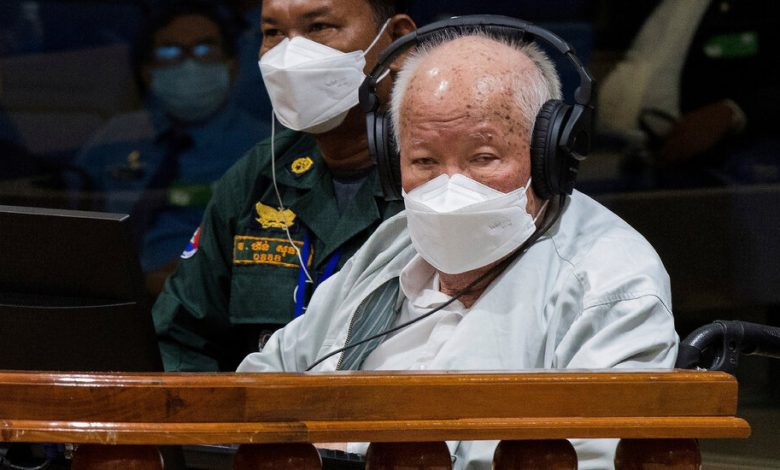16 Years, 3 Convictions: The Khmer Rouge Trials Come to an End

For more than 15 years, a court in a military camp on the outskirts of Phnom Penh worked to bring some measure of justice for the horrors that killed nearly a quarter of Cambodia’s population in the late 1970s. It spent over $330 million. In the end, it convicted just three people.
On Thursday, the Extraordinary Chambers in the Courts of Cambodia — a United Nations-backed tribunal charged with prosecuting the crimes of the Khmer Rouge regime — held its final hearing. It rejected an appeal by Khieu Samphan, 91, the fanatical communist movement’s last surviving leader, upholding his conviction and life sentence for genocide, as well as his convictions for other crimes.
As the ruling was read, Mr. Khieu Samphan, his face partially obscured by large black headphones and a white face mask, sank lower into his seat.
During its four years in power, from 1975 to 1979, the Khmer Rouge caused the deaths of an estimated 1.7 million Cambodians from execution, torture, starvation and untreated disease as it sought to abolish modernity and create an agrarian utopia.
For many Cambodians who survived one of the worst mass killings of a bloody century, the fact that the tribunal delivered so few convictions, so many years after the atrocities were committed, made it seem a hollow exercise. Many of the Khmer Rouge’s senior figures — including its notorious top leader, Pol Pot — were long dead by the time the court was created.
“The Khmer Rouge leaders have died,” said Yun Bin, 67, who was beaten and left for dead in a ditch by the regime’s cadres. “Some victims in my village have already died.”
Mr. Khieu Samphan, urbane and multilingual, was the nominal leader and presentable face of the Khmer Rouge and a member of its tight-knit inner circle. During the tribunal’s proceedings, Mr. Khieu Samphan insisted that he was “not aware of the heinous acts committed by other leaders.”
Delayed by war and politics, the tribunal, jointly administered by the United Nations and the Cambodian government, was not formally established until 2006, more than a quarter-century after a Vietnamese invasion drove the Khmer Rouge from power.
Its awkward pairing of two judicial systems, and two often-conflicting views of its purpose, led to delays and sometimes-acrimonious disputes. Besides coming under criticism for its high cost and slow pace, the tribunal was marred by corruption and succumbed to pressure from Prime Minister Hun Sen, himself a former Khmer Rouge cadre, to limit the scope of the prosecutions.
All of those problems were foreseeable, said Alexander Hinton, an anthropology professor at Rutgers University who has followed the tribunal and testified before it as an expert witness. Still, he said, it would have been unacceptable not to prosecute the perpetrators of what he called “some of the worst crimes in history.”
“I personally have always had very low expectations for what would happen, and those expectations have been met,” Professor Hinton said in an interview.
But he said the tribunal had shone a light on a time that many older Cambodians would have preferred to forget, and that many younger ones have found hard to believe.
As much as three-quarters of Cambodia’s current population is under 30, and many survivors of the Khmer Rouge have said that their children and grandchildren had dismissed their stories about the time as exaggerated and impossible.
The Khmer Rouge evacuated entire cities, including sick people in hospitals, marching hundreds of thousands into the countryside on foot; created a nationwide system of forced labor camps, torture houses and execution grounds, known as killing fields; banned religion and commerce; tore families apart; and executed people who were seen as part of the old order, in some cases simply because they wore glasses.
Only in the last decade have Cambodian schools begun to teach students about the Khmer Rouge period, spurred in part by the existence of the tribunal.
Youk Chhang, a survivor who heads the Documentation Center of Cambodia, which provided much of the material used by the tribunal, said it was up to the younger generation to learn from the past and work toward “a more optimistic future.”
Indeed, the tribunal’s main achievement was the creation, through meticulous research and trial testimony, of “an empirical record that can never be revised or challenged,” Peter Maguire, an expert on war crimes and the author of “Facing Death in Cambodia,” said in an email.
One of its major shortcomings, he said, was the small number of people it prosecuted, partly because Mr. Hun Sen, the prime minister, feared the trials could run out of control and cause political problems for his government.
Only five people were put on trial, two of whom died before facing judgment. Some of the most important potential defendants, Pol Pot chief among them, died before charges could be brought.
Mr. Khieu Samphan unsuccessfully appealed an earlier conviction, in 2014, for murder and other crimes. He received a life sentence in that case, which would have remained in effect no matter the outcome of his hearing Thursday.
His co-defendant, Nuon Chea, often referred to as Brother Number Two to Pol Pot, was also found guilty in both trials and sentenced to life in prison. He died at 93, less than a year after the two men were convicted of genocide in 2018.
The third person convicted by the tribunal was Kaing Guek Eav, known as Duch, the commander of the central Khmer Rouge prison in Phnom Penh. Thousands of people were tortured there before being brought to a killing field on the city’s outskirts and executed. He was sentenced in 2012 to life in prison for crimes against humanity and died in 2020, at 77.
Though the hearing Thursday marked the end of the tribunal’s active litigation, it will not mean the end of the court itself, said Craig Etcheson, an expert on the proceedings and a former visiting scientist at Harvard University’s School of Public Health.
There now comes a three-year “legacy period,” during which donor governments may decide to fund such follow-up projects as public outreach, support for victims who participated in the trial, preservation of archives and analysis of the court’s jurisprudence.
“It is not over yet,” said Mr. Youk Chhang of the Documentation Center of Cambodia. “We have at least five million survivors — one third of the population — who suffered at the hands of the Khmer Rouge whose stories have not even been heard or documented.”
One of them is a 66-year-old man named Nak, who dismissed the entire tribunal process as a political exercise. He would not give his full name, saying he still feared retribution for speaking his mind.
“People are already dead,” he said. “The trial doesn’t mean anything to them. It is a waste of money to have the trial.”





